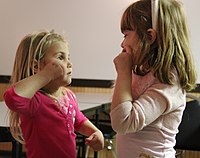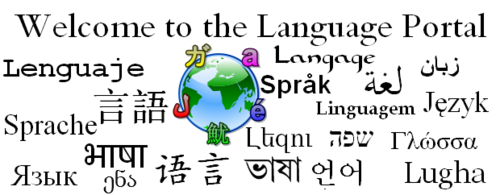Introduction




Language is a structured system of communication that consists of grammar and vocabulary. It is the primary means by which humans convey meaning, both in spoken and signed forms, and may also be conveyed through writing. Human language is characterized by its cultural and historical diversity, with significant variations observed between cultures and across time. Human languages possess the properties of productivity and displacement, which enable the creation of an infinite number of sentences, and the ability to refer to objects, events, and ideas that are not immediately present in the discourse. The use of human language relies on social convention and is acquired through learning.
Estimates of the number of human languages in the world vary between 5,000 and 7,000. Precise estimates depend on an arbitrary distinction (dichotomy) established between languages and dialects. Natural languages are spoken, signed, or both; however, any language can be encoded into secondary media using auditory, visual, or tactile stimuli – for example, writing, whistling, signing, or braille. In other words, human language is modality-independent, but written or signed language is the way to inscribe or encode the natural human speech or gestures.
Depending on philosophical perspectives regarding the definition of language and meaning, when used as a general concept, "language" may refer to the cognitive ability to learn and use systems of complex communication, or to describe the set of rules that makes up these systems, or the set of utterances that can be produced from those rules. All languages rely on the process of semiosis to relate signs to particular meanings. Oral, manual and tactile languages contain a phonological system that governs how symbols are used to form sequences known as words or morphemes, and a syntactic system that governs how words and morphemes are combined to form phrases and utterances.
The scientific study of language is called linguistics. Critical examinations of languages, such as philosophy of language, the relationships between language and thought, how words represent experience, etc., have been debated at least since Gorgias and Plato in ancient Greek civilization. Thinkers such as Jean-Jacques Rousseau (1712–1778) have argued that language originated from emotions, while others like Immanuel Kant (1724–1804) have argued that languages originated from rational and logical thought. Twentieth century philosophers such as Ludwig Wittgenstein (1889–1951) argued that philosophy is really the study of language itself. Major figures in contemporary linguistics include Ferdinand de Saussure and Noam Chomsky. (Full article...)
Selected language -
Biblical Hebrew (Hebrew: עִבְרִית מִקְרָאִית, romanized: ʿiḇrîṯ miqrāʾîṯ (Ivrit Miqra'it) or לְשׁוֹן הַמִּקְרָא, ləšôn ham-miqrāʾ (Leshon ha-Miqra)), also called Classical Hebrew, is an archaic form of the Hebrew language, a language in the Canaanitic branch of the Semitic languages spoken by the Israelites in the area known as the Land of Israel, roughly west of the Jordan River and east of the Mediterranean Sea. The term ʿiḇrîṯ 'Hebrew' was not used for the language in the Hebrew Bible, which was referred to as שְֹפַת כְּנַעַן śəp̄aṯ kənaʿan 'language of Canaan' or יְהוּדִית Yəhûḏîṯ 'Judean', but it was used in Koine Greek and Mishnaic Hebrew texts. The Hebrew language is attested in inscriptions from about the 10th century BCE, when it was almost identical to Phoenician and other Canaanite languages, and spoken Hebrew persisted through and beyond the Second Temple period, which ended in 70 CE with the siege of Jerusalem. It eventually developed into Mishnaic Hebrew, which was spoken until the 5th century.
The language of the Hebrew Bible reflects various stages of the Hebrew language in its consonantal skeleton, as well as a vocalization system which was added in the Middle Ages by the Masoretes. There is also some evidence of regional dialectal variation, including differences between Biblical Hebrew as spoken in the northern Kingdom of Israel and in the southern Kingdom of Judah. The consonantal text called the Masoretic Text was transmitted in manuscript form and underwent redaction in the Second Temple period, but its earliest portions (parts of Amos, Isaiah, Hosea and Micah) can be dated to the late 8th to early 7th centuries BCE. (Full article...)
Did you know (auto-generated)

- ... that an erroneous claim that the neural language model LaMDA is sentient has generated conversations on the efficacy of the Turing test?
- ... that when Felicia Schroeder signed to play soccer for the University of South Carolina, the school did not have a sign-language interpreter available for her?
- ... that Australia has three major Japanese language schools?
- ... that after visiting Hungary in 2015, members of Action Deaf Youth headed to Stormont to demand better sign language support in Northern Ireland?
- ... that Kannada-language author M. V. Seetharamiah established that the Rashtrakuta emperor Nrupatunga did not write the classic Kavirajamarga?
- ... that Dorothy Stanley was once said to be one of the last speakers of the Miwok languages?
More did you know -
- ...that Otomi grammar, the grammar of the indigenous Otomi language of Mexico has traits of active/stative alignment, but has no adjectives?
- ...that Albert White Hat, translator for the movie Dances With Wolves, taught the Lakota language at Sinte Gleska University?
- ...that in 1998, the Hopi Dictionary: Hopìikwa Lavàytutuveni, the first comprehensive Hopi language dictionary, was almost prevented from being published for fear of having non-Hopis learning the language?
- ...that the Native American Languages Act of 1990 was the first time Congress gave official status to Native American languages for the purpose of conducting tribal business?
Categories
Linguistics: Computational linguistics • Grammar • Historical linguistics • Morphology • Phonetics • Phonology • Pragmatics • Reading • Semantics • Sociolinguistics • Syntax • Writing
Languages: Language families • Pidgins and creoles • Sign languages
Linguists: By nationality • Historical linguists • Morphologists • Phoneticians • Phonologists • Sociolinguists • Syntacticians • Translators
Stubs: Constructed languages • Languages • Linguists • Pidgins and creoles • Typography • Vocabulary and usage • Writing systems
Full Language category tree
|
|---|
|
Select [►] to view subcategories
|
Related portals
Selected topic -
Esperanto is a constructed international auxiliary language designed to have a simple phonology. The creator of Esperanto, L. L. Zamenhof, described Esperanto pronunciation by comparing the sounds of Esperanto with the sounds of several major European languages.
With over a century of use, Esperanto has developed a phonological norm, including accepted details of phonetics, phonotactics, and intonation, so that it is now possible to speak of proper Esperanto pronunciation and of properly formed words independently of the languages originally used to describe it. This norm accepts only minor allophonic variation. (Full article...)
Selected picture -

Countries and regions where Portuguese has official status
Language News
- 1 March 2025 – Executive orders in the second presidency of Donald Trump
- United States President Donald Trump signs an executive order designating English as the country's official language. (The Guardian)
- 27 February 2025 –
- OpenAI releases their latest large language model, GPT-4.5. (The Verge)
- 22 November 2024 – Censorship in Belarus
- In a speech at Minsk State Linguistic University, Belarusian President Alexander Lukashenko threatens to shut down the Internet in his country if there are mass protests before the upcoming presidential election after the previous election saw mass protests. (Rferl)
Topics

Languages of Africa: Arabic, Chadic, Cushitic, Kanuri, Maasai, Setswana, Swahili, Turkana, Xhosa, Yoruba, Zulu, more...
Languages of the Americas: Aleut, Carib, Cherokee, Inuktitut, Iroquois, Kootenai, Mayan, Nahuatl, Navajo, Quechuan, Salish, American Sign Language, more...
Languages of Asia: Arabic, Assamese, Balochi, Bengali, Chinese, Japanese, Hajong, Hebrew, Hindustani, Kannada, Kokborok, Marathi, Khasi, Korean, Kurdish, Malayalam, Manipuri, Meithei, Mongolian, Persian, Rajasthani, Sindhi, Sanskrit, Sylheti, Tamil, Tanchangya, Tulu, Telugu, Tibetan, Thai, Turkish, Vietnamese, Khowar, more...
Languages of Austronesia: Austric, Fijian, Hawaiian, Javanese, Malagasy, Malay, Maori, Marshallese, Samoan, Tahitian, Tagalog, Tongan, Auslan, more...
Languages of Europe: Basque, Czech, Danish, Dutch, English (book), French, German, Greek, Italian, Latin, Leonese, Norwegian, Polish, Portuguese, Romanian, Russian, Slovak, Spanish, Ukrainian more...
Constructed languages: Esperanto, Ido, Volapük, more...
Agglutinative language, Analytic language, Constructed language, Creole, Context-free language, Extinct language, Dialect, Fusional language, Inflectional language, International language, Isolating language, Language isolate, National language, Natural language, Pidgin, Pluricentric language, Polysynthetic language, Proto-language, Sign language, Spoken language, Synthetic language, Variety (linguistics)

Applied linguistics, Cognitive linguistics, Accent (dialect), Computational linguistics, Descriptive linguistics, Eurolinguistics, Generative linguistics, Historical linguistics, Lexicology, Lexical semantics, Morphology, Onomasiology, Phonetics, Phonology, Pragmatics, Prescription, Prototype semantics, Psycholinguistics, Semantics, Stylistics, Sociolinguistics, Syntax
See also: List of linguists

Alphabets: Arabic alphabet, Bengali alphabet, Cyrillic alphabet, Hebrew alphabet, Latin alphabet, more...
Other writing systems: Abjad, Abugida, Braille, Hieroglyphics, Logogram, Syllabary, SignWriting, more..
See also: History of the alphabet, Script
Associated Wikimedia
The following Wikimedia Foundation sister projects provide more on this subject:
-
 Commons
Commons
Free media repository -
 Wikibooks
Wikibooks
Free textbooks and manuals -
 Wikidata
Wikidata
Free knowledge base -
 Wikinews
Wikinews
Free-content news -
 Wikiquote
Wikiquote
Collection of quotations -
 Wikisource
Wikisource
Free-content library -
 Wikiversity
Wikiversity
Free learning tools -
 Wiktionary
Wiktionary
Dictionary and thesaurus
Find a language
| Enter an ISO 639 code to find the corresponding language article |
-

-

-

-

-
Random portal


















